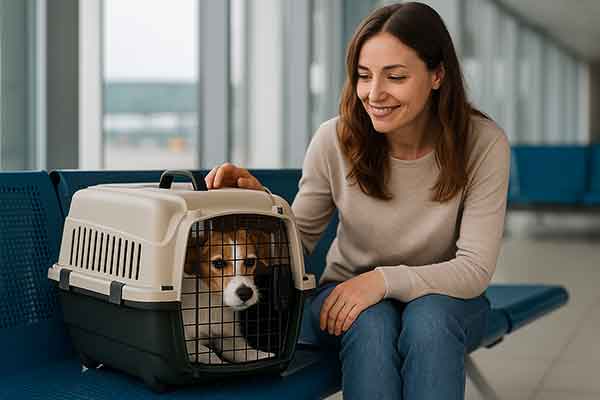How to Fly With Your Dog? | Complete Travel Guide for Pet Owners
Flying with your dog may seem stressful, but with the right planning and preparation, it can be a smooth experience for both of you. Whether you’re relocating, going on vacation, or traveling for business, knowing how to fly with your dog safely is essential.
This comprehensive guide covers everything you need to know about flying with a dog—airline policies, crate and carrier tips, in-cabin vs. cargo travel, documents, and safety practices—so you can confidently take to the skies with your furry friend.
Table of Contents
- Is It Safe to Fly With a Dog?
- Can Dogs Fly on Planes? Airline Rules and Restrictions
- Cabin vs. Cargo: Where Will Your Dog Travel?
- How to Prepare Your Dog for Air Travel
- Packing Checklist for Flying With a Dog
- What to Do on the Day of Travel
- Caring for Your Dog After Landing
- FAQ
Is It Safe to Fly With a Dog?
Yes, in most cases, flying with your dog is safe, especially when they travel in the cabin. However, there are risks involved—particularly when dogs are transported in the cargo hold, where conditions may be less comfortable.
To ensure safety:
- Use a properly ventilated, IATA-approved travel crate
- Choose direct flights to reduce transit stress
- Consult with your veterinarian before the flight
Senior dogs, snub-nosed breeds (like pugs or bulldogs), or dogs with medical conditions may be at greater risk. Always check with your vet and the airline before booking a flight.
Can Dogs Fly on Planes? Airline Rules and Restrictions
Yes, most airlines allow dogs on planes, but rules vary depending on the carrier, destination, and size of your dog.
General airline requirements include:
- Small dogs: Usually allowed in the cabin inside a soft-sided carrier that fits under the seat
- Large dogs: Must travel in the cargo hold in a hard-sided kennel
- Service dogs: Allowed in the cabin, usually at no extra charge
- Emotional support animals: No longer accepted as service animals on many airlines
Top airlines that allow dogs: Alaska Airlines, American Airlines, Delta, United, Southwest, and JetBlue—each with its own pet policy.
Cabin vs. Cargo: Where Will Your Dog Travel?
In-Cabin Travel
Flying with your dog in the cabin is ideal. Requirements usually include:
- Dog weighs under 15–20 pounds (with carrier)
- Carrier fits under the seat in front of you
- Advance reservation and pet fee (typically $95–$125 one-way)
Cargo Hold Travel
For larger dogs, airlines may offer pet-safe cargo services. While it’s more stressful for your pet, reputable airlines take great care with temperature control and safety.
Tips for cargo travel:
- Book direct flights
- Avoid summer and winter extremes
- Attach clear labels on the crate
- Include a frozen water dish that melts during the flight
How to Prepare Your Dog for Air Travel
Preparation is key to a smooth journey:
1. Visit the Veterinarian
- Schedule a check-up within 10 days of departure
- Request a health certificate (may be required for interstate or international travel)
- Ensure all vaccinations are current
2. Crate Train Your Dog
- Introduce the crate weeks in advance
- Make it a positive space with treats and toys
- Practice short “flights” at home to get them used to staying in the carrier
3. Avoid Sedatives
Most vets do not recommend sedatives as they can interfere with your dog’s ability to regulate temperature and balance. Natural calming sprays or treats are safer alternatives.
4. Check Entry Requirements
For international flights, research the entry rules of your destination country. Some require quarantine, import permits, or rabies titer tests.

Packing Checklist for Flying With a Dog
Be sure to pack these dog travel essentials:
- Crate or airline-approved soft-sided carrier
- Leash and harness
- Travel bowls and bottled water
- Dog food and treats
- Absorbent potty pads
- Comfort item (blanket, toy)
- Health certificate and vaccination records
- ID tags and microchip details
What to Do on the Day of Travel
1. Arrive Early
Arrive at the airport 2–3 hours early for domestic flights (3–4 for international). Check in with the airline’s pet desk if applicable.
2. Potty Break Before Security
Give your dog a bathroom break before entering the terminal. Many airports also have pet relief areas post-security.
3. Feed Lightly
Give your dog a small meal 4–6 hours before the flight to avoid motion sickness. Avoid feeding right before departure.
4. Stay Calm
Your energy affects your dog. Stay calm, reassuring, and avoid overly stimulating them before boarding.
Caring for Your Dog After Landing
Once you’ve reached your destination:
- Take your dog to a relief area immediately
- Offer water and a light meal if they’ve gone several hours without food
- Monitor for signs of stress or illness (vomiting, panting, disorientation)
- Let them rest and adjust gradually to the new environment
Some dogs bounce back quickly, while others may need a few hours or days to feel normal again after flying.
FAQ
How much does it cost to fly with a dog?
It depends on the airline and your dog’s size. In-cabin pet fees typically range from $95 to $125. Cargo fees can exceed $200–$500 depending on distance and carrier.
Do I need a health certificate for my dog to fly?
Yes, most airlines require a health certificate issued within 10 days of departure. International travel may require additional documents or quarantine.
Can I buy a seat for my dog?
Most airlines do not allow you to purchase an extra seat for your dog. Dogs must remain in their carrier under the seat unless they are a registered service animal.
What if my dog barks during the flight?
Keep your dog calm by choosing a carrier they’re familiar with, using a blanket to reduce stimuli, and avoiding overstimulation before the flight. Some barking is tolerated, but constant disruption could become an issue.
Is flying stressful for dogs?
Yes, it can be, especially for dogs unfamiliar with travel or noise-sensitive breeds. Proper crate training, pre-flight conditioning, and calm behavior from owners can help minimize stress.
Conclusion
Flying with your dog is completely doable with proper planning. From understanding airline policies to preparing your pet for the journey, every step you take in advance reduces stress and ensures a smoother experience.
Whether you’re flying with your small dog in the cabin or transporting a large dog via cargo, safety and comfort should always come first. Consult your veterinarian, choose a pet-friendly airline, and pack thoughtfully to make your travels as enjoyable as possible—for both you and your four-legged travel companion.





